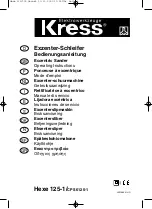
16
WARNING:
To avoid injury from accidental startups, always ensure that the tool is switched OFF and
unplugged from the power supply before making adjustments.
PREPARATION
INTRODUCTION
The drum sander is a machine designed to sand wooden workpieces to a desired thickness and smoothness. Before
adjusting and operating the machine, it is important to know that drum sanding is different from thickness planing.
Drum sanding can only remove material in increments of 1/32 inch (0.8mm) or less, depending on the sanding grit,
material hardness, sanding width, etc. The drum sander is not suitable for quick bulk material removal. Forcing your
drum sander to remove too much material too fast will cause damage to your machine and the workpiece.
WORKPIECE INSPECTION
This drum sander is intended for sanding natural and man-made wood materials. This machine cannot sand other
materials such as metal, glass, stone, tile, etc. Make sure to inspect all workpieces before operation and refer to the
list below for materials that you should avoid or take extra care with.
• Foreign objects
Foreign objects such as nails, staples, dirt, rocks, etc. are often embedded in wood. The objects may cause kickback
that can hit the operator and damage the machine. REMOVE those foreign objects before operation.
• Large knots or loose knots
Choose workpieces that do not have large or loose knots. Large knots may cause kickback and damage the ma-
chine. Loose knots in stock can become dislodged during sanding operations.
• Wood species with toxic properties
Wood species such as the rosewood family (e.g. cocobolo) have toxic properties that may result in allergic reac-
tions. Even with dust control, you may inhale small airborne particles and and possibly suffer an allergic reaction.
• Highly resinous species
Highly resinous species tend to quickly clog or load up sandpaper easily. This includes some common pine spe-
cies. It is almost impossible to clear the sandpaper of the pitch and sawdust from those species of wood. Avoid
sanding those wood species or make sure to replace sandpaper often.
• Wet or green stock
Wood stock with a moisture content over 20% causes excessive wear on the sandpaper and motors as you’re sand-
ing. This may increase the risk of kickback and result in a poor surface finish. Use stock with moisture content
below 20%.
• Excessive Warping
Do not sand workpieces with excessive warping or twisting as they are unpredictable and difficult to hold stable.
DO NOT sand workpieces with excessive warping.
Concave
Convex
• Minor Warping
When sanding workpieces with minor warping, make sure the concave side is down-
ward, facing the conveyor belt. Check that the workpiece can be stable and well sup-
ported. Do not place the workpiece with the convex side down, as it will wobble during
operation and cause kickback and possible injury.
Содержание 65910
Страница 31: ......
Страница 32: ...THANKS FOR REMEMBERING ...
















































